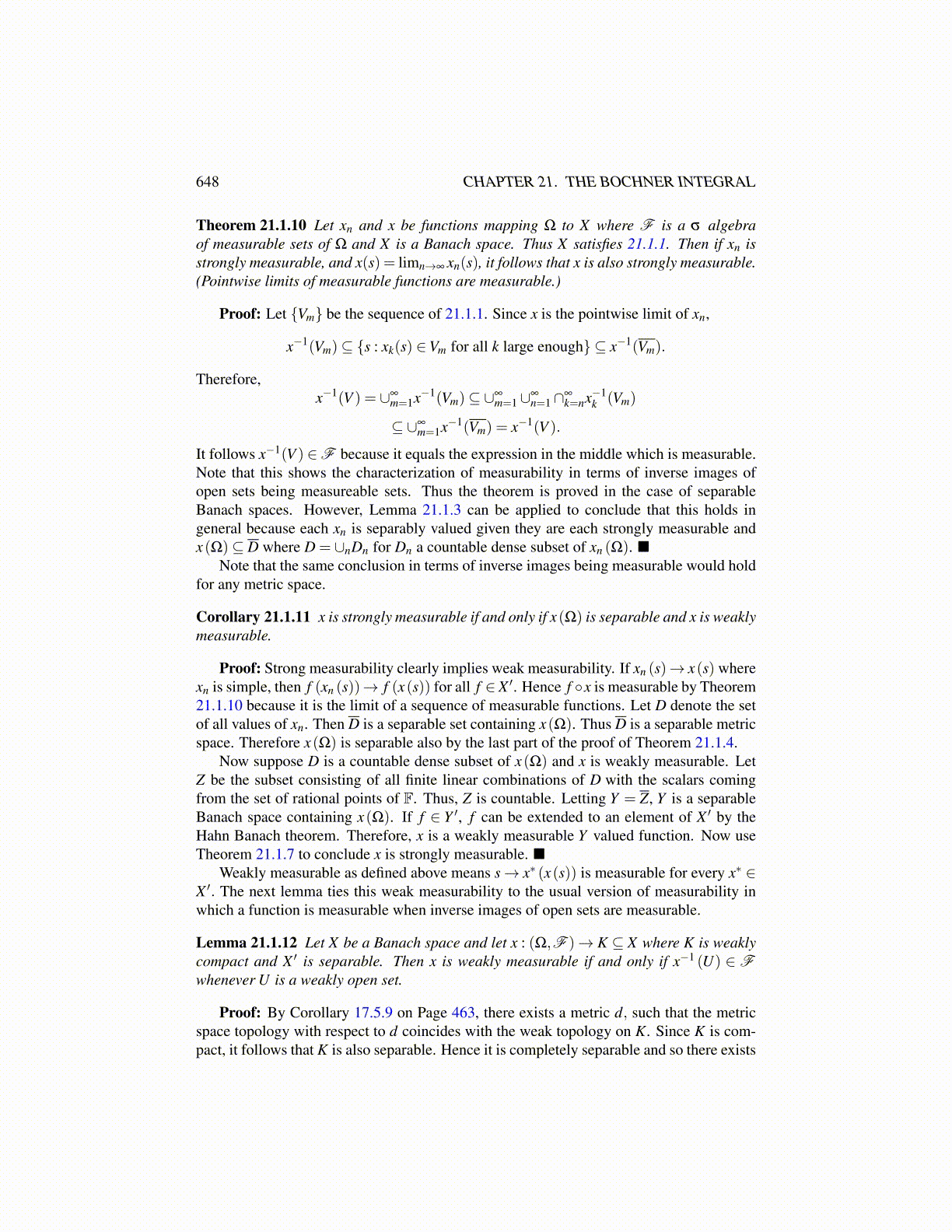
648 CHAPTER 21. THE BOCHNER INTEGRAL
Theorem 21.1.10 Let xn and x be functions mapping Ω to X where F is a σ algebraof measurable sets of Ω and X is a Banach space. Thus X satisfies 21.1.1. Then if xn isstrongly measurable, and x(s) = limn→∞ xn(s), it follows that x is also strongly measurable.(Pointwise limits of measurable functions are measurable.)
Proof: Let {Vm} be the sequence of 21.1.1. Since x is the pointwise limit of xn,
x−1(Vm)⊆ {s : xk(s) ∈Vm for all k large enough} ⊆ x−1(Vm).
Therefore,x−1(V ) = ∪∞
m=1x−1(Vm)⊆ ∪∞m=1∪∞
n=1∩∞k=nx−1
k (Vm)
⊆ ∪∞m=1x−1(Vm) = x−1(V ).
It follows x−1(V ) ∈F because it equals the expression in the middle which is measurable.Note that this shows the characterization of measurability in terms of inverse images ofopen sets being measureable sets. Thus the theorem is proved in the case of separableBanach spaces. However, Lemma 21.1.3 can be applied to conclude that this holds ingeneral because each xn is separably valued given they are each strongly measurable andx(Ω)⊆ D where D = ∪nDn for Dn a countable dense subset of xn (Ω).
Note that the same conclusion in terms of inverse images being measurable would holdfor any metric space.
Corollary 21.1.11 x is strongly measurable if and only if x(Ω) is separable and x is weaklymeasurable.
Proof: Strong measurability clearly implies weak measurability. If xn (s)→ x(s) wherexn is simple, then f (xn (s))→ f (x(s)) for all f ∈X ′. Hence f ◦x is measurable by Theorem21.1.10 because it is the limit of a sequence of measurable functions. Let D denote the setof all values of xn. Then D is a separable set containing x(Ω). Thus D is a separable metricspace. Therefore x(Ω) is separable also by the last part of the proof of Theorem 21.1.4.
Now suppose D is a countable dense subset of x(Ω) and x is weakly measurable. LetZ be the subset consisting of all finite linear combinations of D with the scalars comingfrom the set of rational points of F. Thus, Z is countable. Letting Y = Z, Y is a separableBanach space containing x(Ω). If f ∈ Y ′, f can be extended to an element of X ′ by theHahn Banach theorem. Therefore, x is a weakly measurable Y valued function. Now useTheorem 21.1.7 to conclude x is strongly measurable.
Weakly measurable as defined above means s→ x∗ (x(s)) is measurable for every x∗ ∈X ′. The next lemma ties this weak measurability to the usual version of measurability inwhich a function is measurable when inverse images of open sets are measurable.
Lemma 21.1.12 Let X be a Banach space and let x : (Ω,F )→ K ⊆ X where K is weaklycompact and X ′ is separable. Then x is weakly measurable if and only if x−1 (U) ∈ Fwhenever U is a weakly open set.
Proof: By Corollary 17.5.9 on Page 464, there exists a metric d, such that the metricspace topology with respect to d coincides with the weak topology on K. Since K is com-pact, it follows that K is also separable. Hence it is completely separable and so there exists